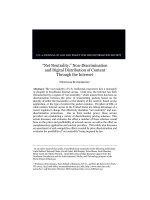Computers and digital basic computer concepts 2014 chapter05 zc
Bạn đang xem bản rút gọn của tài liệu. Xem và tải ngay bản đầy đủ của tài liệu tại đây (3.07 MB, 68 trang )
Chapter 5
Local Area Networks
Computer Concepts 2014
5
Chapter Contents
Section A: Network Building Blocks
Section B: Wired and Wireless Technologies
Section C: Network Setup
Section D: Sharing Files
Section E: Wireless Security
Chapter 5: Local Area Networks
2
FastPoll True/False Questions
5
Answer A for True and B for False
050100 The networks typically installed by individuals in homes are classified as LANs.
050200 High bandwidth networks, such as cable TV and DSL are referred to as broadband.
050300 When you send an e-mail message over a network, it is chopped up into packets.
050400 The IP address assigned to your computer on the Internet is derived from your computer’s MAC
address.
050500 Wired network connections can offer higher speeds than wireless connections.
Chapter 5: Local Area Networks
3
5
FastPoll True/False Questions
Answer A for True and B for False
050600 The most popular type of wired connection is Ethernet.
050700 Network speeds are measured in megabytes and gigabytes.
050800 Many wireless connections use radio waves to transmit data.
050900 Bluetooth is a wireless technology used for WANs.
Chapter 5: Local Area Networks
4
5
FastPoll True/False Questions
Answer A for True and B for False
051000 A wireless infrastructure network uses a centralized broadcasting device, such as
a wireless access point or router.
051100 Wireless connections are less secure than wired networks.
051200 A hub can be used to extend a network by adding additional wired devices.
051300 To configure a router, you usually have to start a browser and enter the router’s IP
address.
Chapter 5: Local Area Networks
5
5
FastPoll True/False Questions
Answer A for True and B for False
051400 A homegroup is a temporary network of handheld computers.
051500 Public key encryption uses a public key to encrypt messages, but a private key is
required to decrypt messages.
Chapter 5: Local Area Networks
6
5
Section A: Network Building Blocks
Network Classifications
LAN Advantages and Disadvantages
Network Devices
Network Links
Communications Protocols
Chapter 5: Local Area Networks
7
5
Question
052100 Networks come in many sizes and use many different technologies, yet they all
need to communicate with each other. What is the key to network intercommunication?
A. Circuit switching
B. Network protocols
C. Network topology
D. Peer-to-peer technology
Chapter 5: Local Area Networks
8
5
Network Classifications
Personal Area Network (PAN) – interconnection of personal digital devices or consumer
electronics
Local Area Network (LAN) – connects computers in a limited geographical area
Metropolitan Area Network (MAN) – public high-speed network with range of about 50
miles
Wide Area Network (WAN) – covers a large geographical area and typically consists of
several smaller networks
Chapter 5: Local Area Networks
9
5
LAN Advantages and Disadvantages
LANs enable people to work together
Sharing networked software can reduce costs
Sharing data on a LAN can increase productivity
Sharing networked hardware can reduce costs
Sharing an Internet connection can be cost-effective and convenient
Sharing networked hardware can provide access to a wide range of services and
specialized peripheral devices
Chapter 5: Local Area Networks
10
5
LAN Advantages and Disadvantages
One disadvantage of LANs is that when a network malfunctions, all the resources you’re
accustomed to accessing are unavailable until the network is repaired
LANs are vulnerable to unauthorized access
LANs are vulnerable to malicious code
Chapter 5: Local Area Networks
11
5
Network Devices
Each connection point on a network is a node
To connect to a LAN, a computer requires network circuitry, sometimes referred to as a network interface
card (NIC)
A networked peripheral, or network-enabled peripheral, is any device that contains network circuitry to
directly connect to a network
A storage device that directly connects to a network is called network attached storage (NAS)
A network device, or network appliance, is any electronic device that broadcasts network data, boosts
signals, or routes data to its destination
Chapter 5: Local Area Networks
12
5
Network Devices
Chapter 5: Local Area Networks
13
5
Network Links
A communications channel, or link, is a physical path or frequency for signal
transmissions
Bandwidth is the transmission capacity of a communications channel
Broadband
Narrowband
Chapter 5: Local Area Networks
14
5
Communications Protocols
Rules for efficiently transmitting data from one network node to another:
Divide messages into packets
Affix addresses to packets
Initiate transmission
Regulate flow of data
Check for transmission errors
Acknowledge receipt of transmitted data
Chapter 5: Local Area Networks
15
5
Communications Protocols
A packet is a “parcel” of data that is sent
across a computer network
Circuit-switching technology vs. packet
switching technology
Chapter 5: Local Area Networks
16
5
Communications Protocols
Every packet that travels over a network includes the address of its destination device
A MAC address is a unique number assigned to a network interface card when it is
manufactured
An IP address is a series of numbers used to identify a network device
IP addresses can be obtained through DHCP
Chapter 5: Local Area Networks
17
5
Section B: Wired and Wireless Technologies
Wired Basics
Ethernet
Wireless Basics
Bluetooth
Wi-Fi
/>
Chapter 5: Local Area Networks
18
5
Question
052200 Suppose your friend has a home office and usually does most work on a desktop computer.
Your friend also has a smartphone and tablet computer that could benefit from Internet access. What
kind of network would you recommend?
A. A network that has a wireless router that provides wireless and wired connections as well as
Internet access
B. A cloud network that can be accessed from a bridge device
C. A file server
D. A 100 gigabit Ethernet network
Chapter 5: Local Area Networks
19
5
Wired Basics
A wired network uses cables to connect network devices
Wired networks are fast, secure, and simple to configure
Wired connections are more secure than their wireless
counterparts
Devices tethered to cables have limited mobility
Chapter 5: Local Area Networks
20
5
Ethernet
Ethernet is a wired network technology that is defined by IEEE 802.3 standards
Simultaneously broadcasts data packets to all network devices
Vary in speed from 10Mbps to 100Gbps
Chapter 5: Local Area Networks
21
5
Ethernet
Chapter 5: Local Area Networks
22
5
Wireless Basics
Wireless network technology transports data from one device to another without cables or
wires
RF signals
Transceiver
Microwaves
Infrared light
Slower than wired networks
Security concerns
Chapter 5: Local Area Networks
23
5
Bluetooth
Bluetooth is a short-range, wireless network technology designed to make its own
connections between two devices
Chapter 5: Local Area Networks
24
5
Wi-Fi
Wi-Fi refers to a set of wireless networking technologies defined by IEEE 802.11
standards
Wireless ad-hoc protocol
Wireless infrastructure protocol
Chapter 5: Local Area Networks
25









